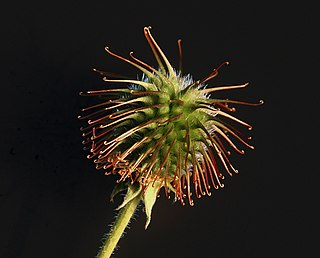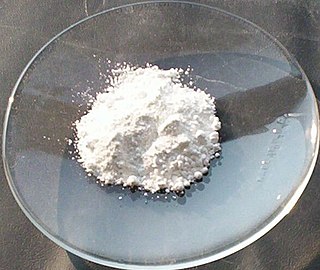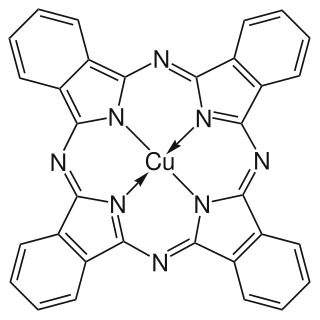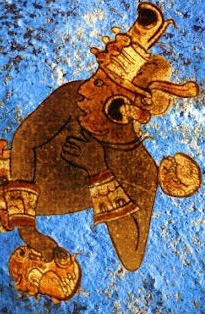Related Research Articles

Hematite, also spelled as haematite, is a common iron oxide compound with the formula, Fe2O3 and is widely found in rocks and soils. Hematite crystals belong to the rhombohedral lattice system which is designated the alpha polymorph of Fe
2O
3. It has the same crystal structure as corundum (Al
2O
3) and ilmenite (FeTiO
3). With this it forms a complete solid solution at temperatures above 950 °C (1,740 °F).

Ink is a gel, sol, or solution that contains at least one colorant, such as a dye or pigment, and is used to color a surface to produce an image, text, or design. Ink is used for drawing or writing with a pen, brush, reed pen, or quill. Thicker inks, in paste form, are used extensively in letterpress and lithographic printing.

Biomimetics or biomimicry is the emulation of the models, systems, and elements of nature for the purpose of solving complex human problems. The terms "biomimetics" and "biomimicry" are derived from Ancient Greek: βίος (bios), life, and μίμησις (mīmēsis), imitation, from μιμεῖσθαι (mīmeisthai), to imitate, from μῖμος (mimos), actor. A closely related field is bionics.

Titanium dioxide, also known as titanium(IV) oxide or titania, is the inorganic compound with the chemical formula TiO
2. When used as a pigment, it is called titanium white, Pigment White 6 (PW6), or CI 77891. It is a white solid that is insoluble in water, although mineral forms can appear black. As a pigment, it has a wide range of applications, including paint, sunscreen, and food coloring. When used as a food coloring, it has E number E171. World production in 2014 exceeded 9 million tonnes. It has been estimated that titanium dioxide is used in two-thirds of all pigments, and pigments based on the oxide have been valued at a price of $13.2 billion.

Iron oxides are chemical compounds composed of iron and oxygen. Several iron oxides are recognized. Often they are non-stoichiometric. Oxyhydroxides are a related class of compounds, perhaps the best known of which is rust.

Zinc oxide is an inorganic compound with the formula ZnO. It is a white powder which is insoluble in water. ZnO is used as an additive in numerous materials and products including cosmetics, food supplements, rubbers, plastics, ceramics, glass, cement, lubricants, paints, sunscreens, ointments, adhesives, sealants, pigments, foods, batteries, ferrites, fire retardants, semi conductors, and first-aid tapes. Although it occurs naturally as the mineral zincite, most zinc oxide is produced synthetically.

Copper phthalocyanine (CuPc), also called phthalocyanine blue, phthalo blue and many other names, is a bright, crystalline, synthetic blue pigment from the group of dyes based on phthalocyanines. Its brilliant blue is frequently used in paints and dyes. It is highly valued for its superior properties such as light fastness, tinting strength, covering power and resistance to the effects of alkalis and acids. It has the appearance of a blue powder, insoluble in most solvents including water.

Dyeing is the application of dyes or pigments on textile materials such as fibers, yarns, and fabrics with the goal of achieving color with desired color fastness. Dyeing is normally done in a special solution containing dyes and particular chemical material. Dye molecules are fixed to the fiber by absorption, diffusion, or bonding with temperature and time being key controlling factors. The bond between the dye molecule and fiber may be strong or weak, depending on the dye used. Dyeing and printing are different applications; in printing, color is applied to a localized area with desired patterns. In dyeing, it is applied to the entire textile.
Microencapsulation is a process in which tiny particles or droplets are surrounded by a coating to give small capsules, with useful properties. In general, it is used to incorporate food ingredients, enzymes, cells or other materials on a micro metric scale. Microencapsulation can also be used to enclose solids, liquids, or gases inside a micrometric wall made of hard or soft soluble film, in order to reduce dosing frequency and prevent the degradation of pharmaceuticals.

Quinacridone is an organic compound used as a pigment. Numerous derivatives constitute the quinacridone pigment family, which finds extensive use in industrial colorant applications such as robust outdoor paints, inkjet printer ink, tattoo inks, artists' watercolor paints, and color laser printer toner. As pigments, the quinacridones are insoluble. The development of this family of pigments supplanted the alizarin dyes.
A solvated electron is a free electron in a solution, in which it behaves like an anion. An electron's being solvated in a solution means it is bound by the solution. The notation for a solvated electron in formulas of chemical reactions is "e−". Often, discussions of solvated electrons focus on their solutions in ammonia, which are stable for days, but solvated electrons also occur in water and many other solvents – in fact, in any solvent that mediates outer-sphere electron transfer. The solvated electron is responsible for a great deal of radiation chemistry.

Priverno is a town, comune in the province of Latina, Lazio, central Italy. It was called Piperno until 1927.

Maya blue is a unique bright azure blue pigment manufactured by cultures of pre-Columbian Mesoamerica, such as the Mayans and Aztecs, during a period extending from approximately the 8th century to around 1860 CE. It is found in mural paintings on architectural buildings, ceramic pieces, sculptures, codices, and even in post-conquest Indochristian artworks and mural decorations.
Biotextiles are specialized materials engineered from natural or synthetic fibers. These textiles are designed to interact with biological systems, offering properties such as biocompatibility, porosity, and mechanical strength or are designed to be environmentally friendly for typical household applications. There are several uses for biotextiles since they are a broad category. The most common uses are for medical or household use. However, this term may also refer to textiles constructed from biological waste product. These biotextiles are not typically used for industrial purposes.

Roman concrete, also called opus caementicium, was used in construction in ancient Rome. Like its modern equivalent, Roman concrete was based on a hydraulic-setting cement added to an aggregate.

YInMn Blue, also known as Oregon Blue or Mas Blue, is an inorganic blue pigment that was discovered by Mas Subramanian and his (then) graduate student, Andrew Smith, at Oregon State University in 2009. The pigment is noteworthy for its vibrant, near-perfect blue color and unusually high NIR reflectance. The chemical compound has a unique crystal structure in which trivalent manganese ions in the trigonal bipyramidal coordination are responsible for the observed intense blue color. Since the initial discovery, the fundamental principles of colour science have been explored extensively by the Subramanian research team at Oregon State University, resulting in a wide range of rationally designed novel green, purple, and orange pigments, all through intentional addition of a chromophore in the trigonal bipyramidal coordination environment.
Admir Masic is a scientist, currently an Associate Professor at the Massachusetts Institute of Technology. His research involves characterization of complex biomineralized and archaeological structural materials with the objective of inspiring the design of more sustainable and durable building materials.
Bioinspiration is the development of novel materials, devices, and structures inspired by solutions found in biological evolution and refinement which has occurred over millions of years. The goal is to improve modeling and simulation of the biological system to attain a better understanding of nature's critical structural features, such as a wing, for use in future bioinspired designs. Bioinspiration differs from biomimicry in that the latter aims to precisely replicate the designs of biological materials. Bioinspired research is a return to the classical origins of science: it is a field based on observing the remarkable functions that characterize living organisms and trying to abstract and imitate those functions.
Light harvesting materials harvest solar energy that can then be converted into chemical energy through photochemical processes. Synthetic light harvesting materials are inspired by photosynthetic biological systems such as light harvesting complexes and pigments that are present in plants and some photosynthetic bacteria. The dynamic and efficient antenna complexes that are present in photosynthetic organisms has inspired the design of synthetic light harvesting materials that mimic light harvesting machinery in biological systems. Examples of synthetic light harvesting materials are dendrimers, porphyrin arrays and assemblies, organic gels, biosynthetic and synthetic peptides, organic-inorganic hybrid materials, and semiconductor materials. Synthetic and biosynthetic light harvesting materials have applications in photovoltaics, photocatalysis, and photopolymerization.

The Center for Scientific Studies in the Arts (NU-ACCESS) is a collaborative initiative between Northwestern University and the Art Institute of Chicago. The institute is dedicated to the convergence diverse scientific disciplines applied to the realm of art conservation and study. Established in 2004 and supported by the Andrew W. Mellon Foundation, the center employs scientific and technical methods to investigate and preserve artistic and cultural artifacts, helping to uncover details about their creation, history, and conservation.
References
- 1 2 "A new perspective on ancient materials inspires future innovation". MIT News | Massachusetts Institute of Technology. 20 November 2017. Retrieved 2022-02-08.
- 1 2 Bertrand, Loïc; Gervais, Claire; Masic, Admir; Robbiola, Luc (2018). "Paleo-inspired Systems: Durability, Sustainability, and Remarkable Properties". Angewandte Chemie International Edition. 57 (25): 7288–7295. doi:10.1002/anie.201709303. ISSN 1521-3773. PMID 29154403. S2CID 205405638.
- ↑ Faber, Katherine T.; Casadio, Francesca; Masic, Admir; Robbiola, Luc; Walton, Marc (2021-07-26). "Looking Back, Looking Forward: Materials Science in Art, Archaeology, and Art Conservation". Annual Review of Materials Research. 51 (1): 435–460. Bibcode:2021AnRMS..51..435F. doi:10.1146/annurev-matsci-080819-013103. ISSN 1531-7331. S2CID 235522737.
- ↑ Powell, Devin; Service, Inside Science News. "Ancient Mayans Inspire Modern Fade Proof Dye". phys.org. Retrieved 2022-02-14.
- ↑ Sciau, Philippe; Goudeau, Philippe (25 May 2015). "Ceramics in art and archaeology: a review of the materials science aspects". The European Physical Journal B. 88 (5): 132. Bibcode:2015EPJB...88..132S. doi:10.1140/epjb/e2015-60253-8. ISSN 1434-6028. S2CID 18014681.
- ↑ Bertrand, Loïc; Thoury, Mathieu; Gueriau, Pierre; Anheim, Étienne; Cohen, Serge (2021-07-06). "Deciphering the Chemistry of Cultural Heritage: Targeting Material Properties by Coupling Spectral Imaging with Image Analysis". Accounts of Chemical Research. 54 (13): 2823–2832. doi:10.1021/acs.accounts.1c00063. ISSN 0001-4842. PMID 34143613. S2CID 235481574.
- ↑ Preuss, Paul (2013-06-04). "Roman Seawater Concrete Holds the Secret to Cutting Carbon Emissions". News Center. Retrieved 2022-02-14.
- ↑ Zhang, Yujie; Zhang, Junping; Wang, Aiqin (2015). "Facile preparation of stable palygorskite/methyl violet@SiO2 "Maya Violet" pigment". Journal of Colloid and Interface Science. 457: 254–263. Bibcode:2015JCIS..457..254Z. doi:10.1016/j.jcis.2015.07.030. PMID 26196708.